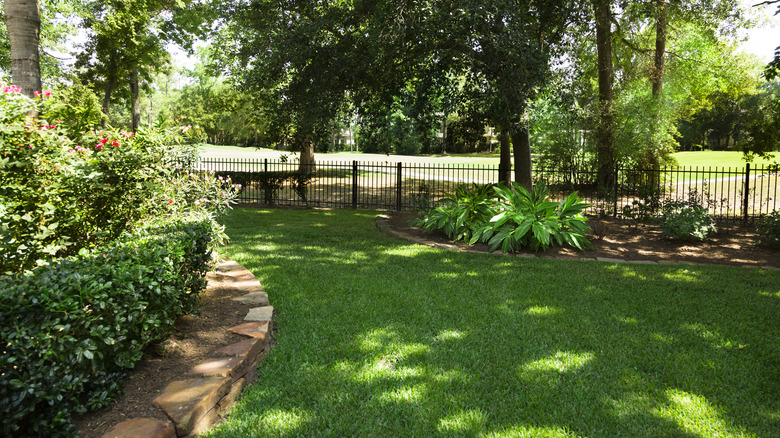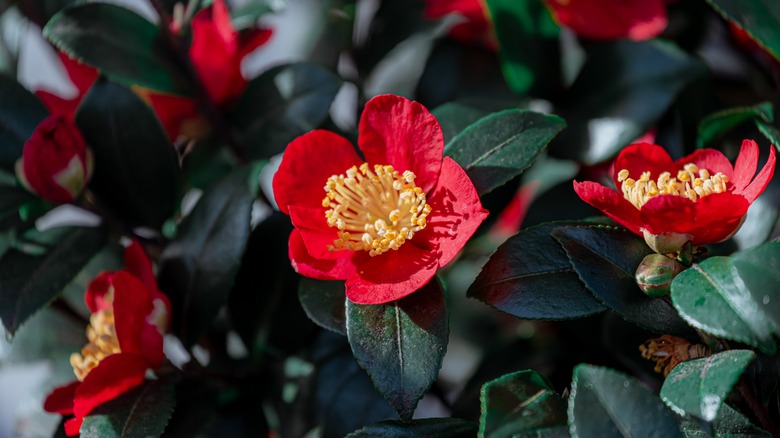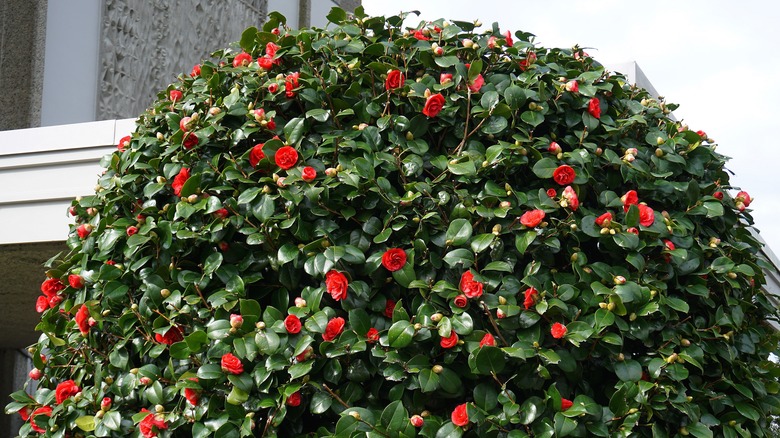This Flowering Shrub Is A Perennial Beauty That Will Thrive In Partial Shade
If your garden has shady spots throughout the day and you want to fill them with greenery, look no further than the gorgeous, delicate Camellia. This leafy perennial shrub adores partial shade and will reward your efforts and attention with large, tender blooms in either late fall or spring, depending on the cultivar. Its lush foliage comes in handy year-round, too. You can use these plants as hedges, privacy screens, or to beautify your home's foundation perimeter.
Camellias hail from South, East, and Southeast Asia, where they're ubiquitous in environments as diverse as Korea's continental climate and Indonesian tropics. They made their debut in the United States back in the 18th century and were first grown in Charleston, S.C. However, nowadays, you'll find camellias in gardens throughout the U.S.'s southern states, the Pacific coast, and as far north as British Columbia. All camellias need to thrive is a warm climate with lots of moisture and a bit of special care during and after planting.
How to plant a new camellia in your garden or backyard
To give your camellias the best opportunity to flourish, you'll have to do a bit of planning before you plant. Start by choosing the best location — one away from full sun and from shallow-rooted trees that could siphon off camellia's water and nutrition. Next, test the soil's pH levels. Camellias do best in neutral-to-acidic soils, so a 5 or slightly lower reading is ideal. You can use a kit from a local home and garden store to quickly perform this acidity test. If the pH level is too high, you can lower the soil's alkalinity with acidifying compounds like elemental sulfur or nitrogen fertilizer.
Once your soil is ready, dig a shallow hole that's wide enough to leave a foot on either side of the plant's root. Place the plant in the hole, and cover up the roots with topsoil. Next, create a soil barrier around the planting area to keep water in, and give the freshly planted camellia a good soak (then repeat on a weekly basis). To avoid crowding, don't situate other camellias too close. A distance of at least five feet between the plants is ideal, but three-foot spacing will suffice if you wish to group the shrubs to produce a privacy screen.
How to care for your camellia and protect it from pests
Camellias need a regular supply of water to maintain growth and promote bud formation. It would be best not to let the soil around them dry out, especially during the flowering season when a lack of hydration can lead to weakened, imperfect blooms. Ideally, camellias' soil should be moist as deep down as a foot and a half. Mulching is just as vital as irrigation. By placing mulch around camellias, you safeguard them from weeds, prevent soil erosion during rain or irrigation, and protect the roots from drastic changes in air temperature. Organic mulch — such as leaves — also serves as a source of nutrition for your camellias.
Camellias can fall prey to a number of pests, such as spider-mites, aphids, and tea scale, which can all damage the plant's lush foliage. Excessive fertilization also can promote infestations. If you don't want your camellias to succumb to these pests, you'll need to look out for signs of trouble and act quickly. If you spot aphids or spider mites anywhere on the camellias, oust them with a forceful washing from your garden hose. Meanwhile, the tea scale must be eradicated with a combination of treatments, such as oil emulsion sprays and insecticides, including Cygon, Orthene, Malathion, and Sevin. You can also take proactive steps to reduce the risks of pest infestations. For example, you can switch to slow-release nitrogen fertilizer or deploy natural insecticides to discourage insects from invading your camellias.


